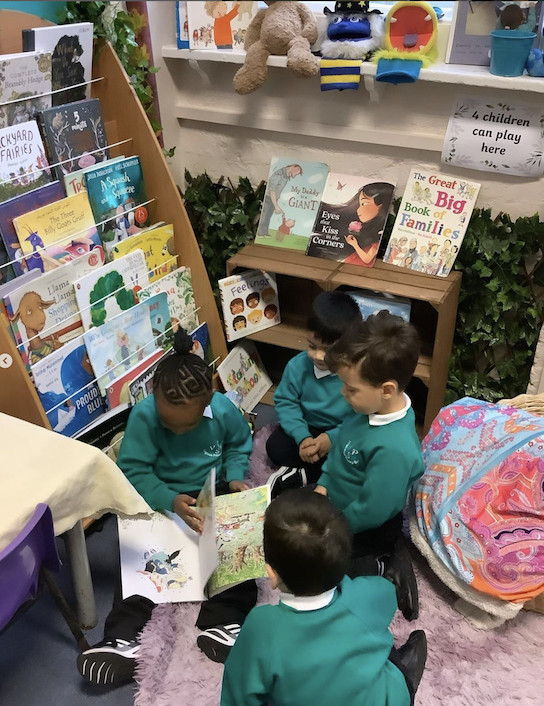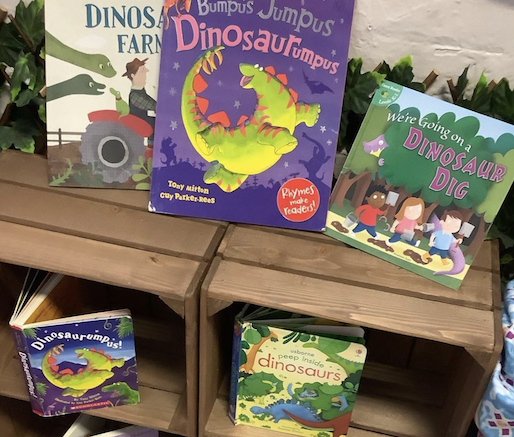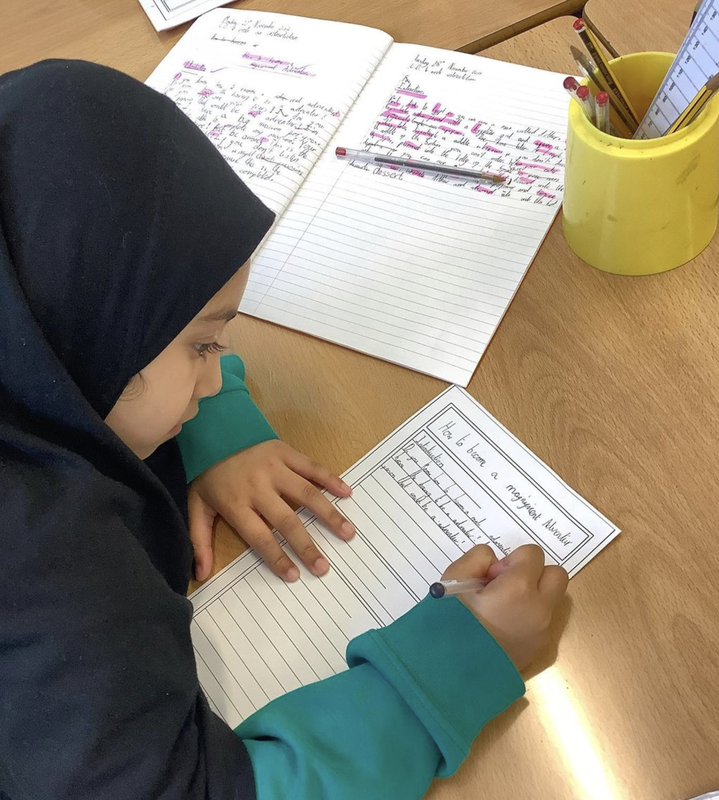English
Vision
- EVERY child is a reader and a writer
- WE love reading and writing
- WE are excellent communicators
- WE are inspired and enthusiastic about our English learning
- WE are creative
- EVERY child has a voice and is confident to use it
Characteristics of good English teaching
We believe that children learn best when:
- they are exposed to a variety of different approaches and strategies;
- they are given a range of experiences and opportunities
- they are encouraged
- they are actively involved in assessment for learning strategies

Learning and Teaching
National Curriculum
The Statutory National Curriculum for English forms the basis of our teaching and Learning of English.
We incorporate a range of other appropriate programs, schemes of work and approaches including:
- Planning from Quality Texts
- THE Partnership Phonics Programme
- Shared Reading
- No Nonsense Spelling Scheme
- Happy Handwriting Scheme
School Thematic Curriculum
Key texts and writing genres will be linked to the half-termly topic.
The rich texts prescribed, help immerse the children into their learning; the wider learning and English lessons working together to support the development of the topic.
This gives children’s narrative and non-fiction reading and writing context and purpose which supports deeper engagement.
Equal Opportunities and Inclusion
All pupils have an equal right to access the English curriculum. We can help children achieve their best through the use of quality first teaching, effective planning, the support of adults and effective use of resource.
A high priority is placed upon the use of high-quality texts, effective modelling of language by all adults and the provision of a rich language environment both in and out of school.
Children are taught in mixed ability groups using the ‘growth mindset’ approach that is embedded across the school.
We use a range of strategies to support differentiation, including:
- Carefully chosen resources and texts
- Writing support aids including word banks, writing frames and scaffolds
- Targeted adult support
- Appropriate grouping of children for guided reading and phonics

Reading
Shared Reading – EYFS/KS1/KS2
During Shared Reading, children are taught the skills of reading and unpicking a text during whole class sessions. The teacher models the reading strategies and the thought processes needed for children to become independent readers. Shared Reading can be based on the class Core Text, or else a text appropriately pitched to the level of the class.
Guided Reading
Guided Reading occurs daily outside the English session from 9.00 -9.30 and is based on a rotation during the week within the class. Guided Reading texts are located in the Library and levelled into colour bands. See the Book Band Level table for more information.
Guided reading session can be led by teachers and teaching assistants.
During an adult-led session children are introduced to the text and reminded of reading strategies. In the early stages of reading, the adult will read the text to the group first, without showing the text but sharing illustrations.
Each child must read independently out loud simultaneously. Then the adult clarifies any unknown vocabulary and strategies for decoding and understanding the unknown words. The adult uses focused questioning to develop pupil understanding of the text.
Children do a follow up activity to reinforce their skills needed to read.
Children are grouped according to ability and when not reading with an adult they are given a related purposeful activity to do independently e.g. follow up activity, comprehensions, spelling, word games, independent reading.
Guided Reading in KS2
Guided Reading may be taught daily (or this may be replaced by daily Shared Reading sessions), if it is deemed necessary for the individual class.
Phonics
Phonics – ‘THE Partnership Phonics Programme’
All the children in EYFS and Key stage 1 have a daily taught 20 minutes phonics session. The children are taught according to their ability, in groups of varying sizes. All adults in EYFS/Key Stage 1 either teach or support the phonics sessions. Discrete phonics sessions are used to teach children the letter sound correspondence in English and the skills of segmenting and blending. We follow the THE Partnership Phonics Programme which is a synthetic phonic system based on the national ‘Letters and Sounds’ phonic scheme.
Sight Words
In EYFS, we begin to teach the children to read sight words. These are the most common words found in books. These are taught in conjunction with the THEP phonics programme. Some sight words cannot be read phonetically, so it is important that children are taught to read these through shared/guided reading and to recognise them out of context. We also give children these words to learn at home. This usually continues throughout year 1 and for part of year 2.
Home Reading
In EYFS and KS1, children are given a reading book at the appropriate level to take home twice a week. In KS2, children are given a reading book at the appropriate level to take home once a week.
We expect all children to read every night at home for at least 20 minutes. They also choose a home reading book from the school library once a week. We encourage parents to read with their children and discuss the books read.
Books they have read at home are recorded in their reading record book and parents are encouraged to comment.
Each class has a set of ‘Top 10 books’. The expectation is that each child reads these 10 books within the year. They can be taken home and this must be monitored by staff.
Writing
Key texts form the basis of our approach to the teaching of writing. We encourage a creative approach to the teaching of writing, where teachers feel able to explore a range of strategies to engage children. However, we have some key principles.
Firstly, we explore the texts as readers, then as writers. We focus on teaching key vocabulary/spelling and grammar from the text.
Fiction
In EYFS/KS1 this will usually be a retelling of a story but might include simple plot innovations like:
- Substitution – change characters, settings, objects
- Alteration of events
- Plot recycle – new story following same basic plot.
In KS2 possible outcomes might include more complex plot innovations including
- Change point of view
- Change story genre
- Reorder, e.g. flashbacks
- Sequels and Prequels

Non-Fiction
We teach the writing of non-fiction in a variety of ways. It may come directly from the key fiction text. It may be linked directly to other aspects of the topic, including Science and the Foundation Subjects (e.g. Non-Chronological Report about The Romans based on research).
We teach pupils the structures and vocabulary that support the different genres of non-fiction.
We expect pupils to create at least one piece of sustained non-fiction writing for each half term topic.
Handwriting
It is very important that children have a consistent and systematic approach to learning how to write for fluency and clarity.
To enable this, we follow the Happy Handwriting scheme to ensure that:
- In EYFS, children are taught to form their letters correctly as part of phonics lessons and also through explicit handwriting lessons
- In year 1, the focus is on size and orientation (descenders/ascenders). It is expected that by the end of year 1 the vast majority of children can consistently form all their letters correctly.
- By the end of year 2, we would expect the majority of children to have begun to learn to join up.
- By the end of year 3, the vast majority of children should be using cursive script consistently and be speedy and fluent.
Spelling and Grammar
Spelling is covered in EYFS/Year 1 using the THEP phonics programme.
We follow the No Nonsense Spelling Scheme from Year 2-Year 6
We use the Grammar Expectations from the National Curriculum.
We embed the teaching of grammar into wider English lessons where possible, but also provide focused lessons and activities where necessary to teach specific aspects of grammar.
